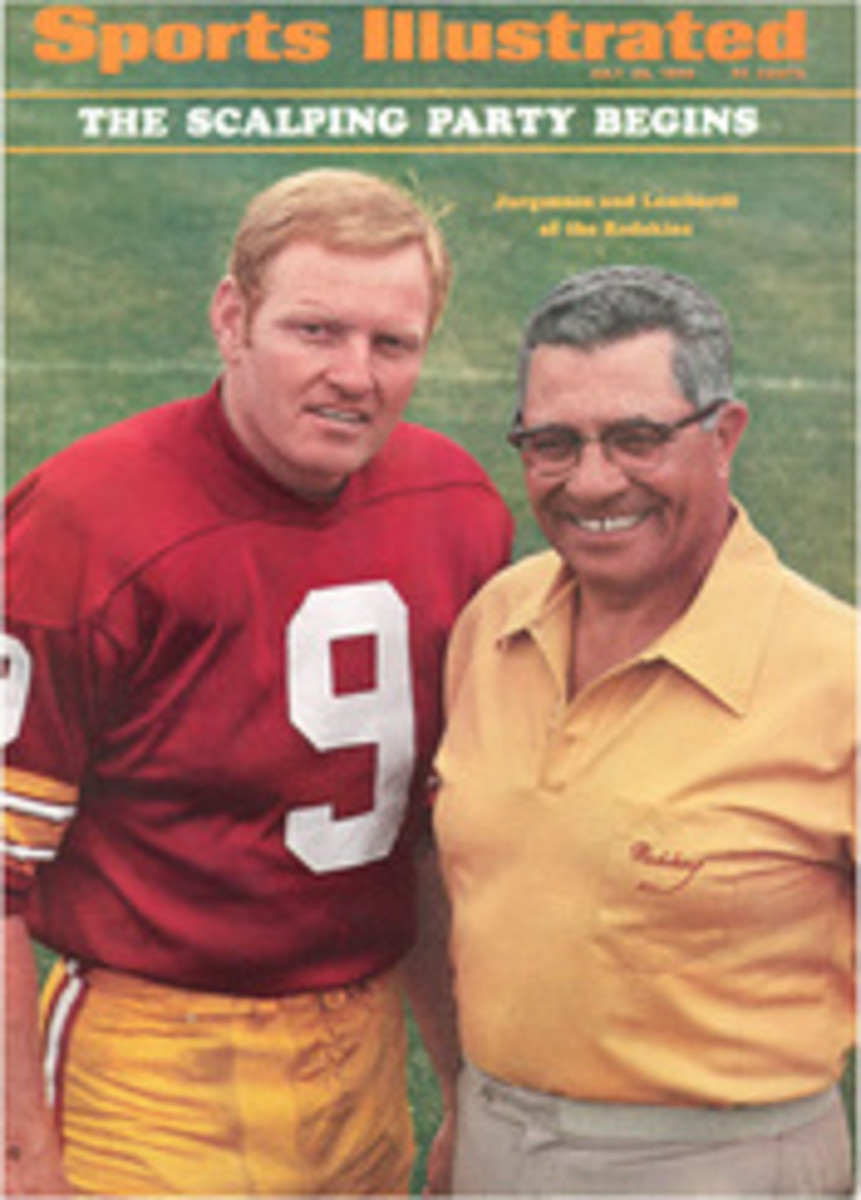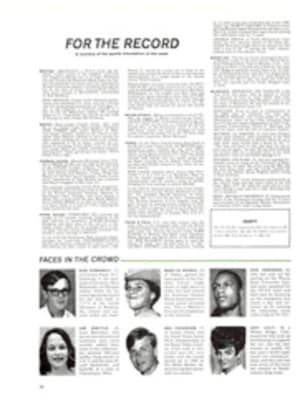
A bonanza in Red Springs
Matt Boykin is a big man made larger by his inability to push himself away from plates full of barbecued pork chops, North Carolina country sausage and creamed corn. Boykin attacks the telephone with a drawl so thunderous that operators must wonder if he realizes there is a wire between his receiver and theirs. Never mind. After 12 profitless, hungry years as general manager of the Wilson, N.C. team in the Class A Carolina League Matt Boykin has found financial success for his team and possibly a whole new approach to minor league baseball, all as a result of a call he made last fall on a hunch.
The number Boykin reached was in Red Springs, a tiny community of small businessmen, mill hands, tobacco growers and tenant cotton farmers in southeastern North Carolina. By the time he crashed down the receiver, his Twins, affiliated with Minnesota, were on the way to Red Springs and profits, and Red Springs was on its way to the best time the town has had since the night in 1913 when most everybody went to jail following a raucous celebration of the semipro team's state championship.
Success is rare enough "in the minors, where the number of teams has dwindled from 432 in 1950 to 141 last year, but in Red Springs? "We have 4,040 people when everyone's here," says Tom Cope, an inveterate cigar chewer and baseball fan who was on the receiving end of Boykin's call in October. Everyone, obviously, is not there often since Red Springs proudly claims on red, white and blue signs along the highways that it is the WORLD'S SMALLEST PROFESSIONAL BASEBALL TOWN.
The smallest town has turned out to be one of the biggest in the Carolina League. Red Springs is one-seventh the size of the next largest city in the league and has 134,000 fewer citizens than Newport News, Va., the leader in attendance. Yet, it has averaged 750 people a game—Minnesota's Assistant Farm Director George Brophy considers 450 good for Class A—and one day last week drew a crowd of 4,157, larger than the population of the town, for a special promotion sponsored by a dairy at which free ice cream was given to each customer. Before the season was half over, more fans had watched the Red Springs Twins at home than attended games in Wilson (pop. 35,000) all last year.
"It sure feels good," says Boykin. "As of July 1, I knew I was clear for the year."
Six months ago it appeared that Boykin, who ran a construction company before switching full-time to baseball when he was 45 years old, was clear out of his mind. The independent minor league owner is a struggling, disappearing breed, and Boykin was hanging on by a slender thread in Wilson. "Every year the Twins would say to me, 'Why don't you close it up in Wilson, Matt?' and I'd answer, 'Let's give it one more try.' Finally last July they told me I'd lose my working agreement—that means my source of players and the money to pay them—if I didn't move."
That is why he discovered Red Springs and Robbins Park, which is owned by a mill in the town. Within two days Boykin received assurances from Red Springs that $2,500 in program advertising would be raised along with another $4,000 in billboards for the outfield wall. The town would arrange to refurbish the park and sell $12,000 worth of season tickets. Without even soliciting, $5,000 in ads came in for the score-cards and $7,000 for the fences.
"It was amazing," says Boykin. "People would call up and demand a sign in the outfield and, when I told them we didn't have any space left, they'd say that they'd take a big ad in the program instead. At first I think a lot of it came because of civic pride, a little town competing against big ones. But now the advertisers realize they're getting an audience of 40,000 people, and it's beginning to sound like good business."
The Cffice of Economic Opportunity chipped in with $10,000 to rejuvenate the park. This was part of a project called Advancement Inc. Designed to pep up the local economy and curtail emigration to Northern cities by providing job training, attracting new industry and improving the quality of life in the region, Advancement Inc. was no boondoggle. Red Springs' county, made up in approximately equal numbers of Indians, blacks and whites, turned out with enthusiasm, particularly the kids, to enjoy virtually the one game in town. The only other entertainment is the movie house, which specializes in Class C shows—Ghidran The Three-Headed Monster was the feature during a recent home stand—and there are no bars because of the WCTU. Not surprisingly, the ball park evolved into a bustling, joyous social center that is part men's club, part lovers' lane and part your neighbor's front porch.
Bill Currie, an insurance agent and avid fan, explains, "I used to try to make some calls in the evening but I began to find out that everyone was at the game. It's great for me. I get to watch the team and I often start a sale at the same time. It's much better than walking up to a house cold and knocking on the door. Here I can run into a guy, start talking baseball and then mention I've heard he's moving into a new house."
Currie and the other adult males, many of whom arrive after the games start because they cannot leave their tobacco fields before nightfall, make up the bulk of the crowds and are a vociferous and startlingly sophisticated lot. The stands in Red Springs are set close to the playing field, so a Twins fan can bait the umpires and know he will be heard, a particularly satisfying feeling in North Carolina, where hot nights and swarms of gnats contribute to the spectators' and the umps' frustrations. The rooters also appreciate the subtleties of good play. In a game not long ago an outfielder who laid down a perfect sacrifice with men on first and second received almost as large a hand as the batter two positions later who hit a three-run triple.
Up in the shadowy back rows of the enclosed grandstand, a three-run triple might well go unnoticed. There the teenagers, who tend to arrive in groups of all boys and all girls, break into couples, hold hands and, insofar as they can avoid the gaze of their elders, make like they are in the front seat of a car at the drive-in movies. "That's one of the things the parents are beginning to realize," says Cope. "In past years the teen-agers were always driving off 20 or 30 miles to the movies, but now they come to the ball park and their parents are relieved to know they're not out on the highways."
The unmarried players, many of whom live in trailers or at McNeill's boardinghouse, a big Victorian building with a rambling porch, and the wives of the married ones are the only people who seem less than enthusiastic about baseball in Red Springs. The traditional image of the strong country-boy ballplayer is not valid today, and many of the Twins come from big cities or suburbs where life is distinctly more varied than it is in a little Southern town. "The people here have treated us like royalty," said one player's wife, sitting with several others and their children in the box reserved for them behind home plate. "But it's boring. There's nothing to do for 30 miles and even the TV is bad. During the day we only get one channel and it doesn't come in too well. At night we can get a couple of others, but they always seem to be showing religious programs. Heck, they don't even play The Star-Spangled Banner when they sign off."
With the diversions of their baseball careers and frequent road trips, the married players, like Outfielders Ezel Carter and Glenn Smith, both from large Midwestern cities, defend the town as a nice quiet place in which to live. But if it were not for the same kind of cynical humor that has sustained American males through 25 years of peacetime conscription, the bachelor players who make up about 50% of the Twins' roster might be just as unhappy in their boredom as the wives. They spend several hours a day crowded into booths at Ma Eason's Good Food Cafeteria, gulping down fried chicken, rice and peas as the elderly proprietress brings on endless servings of hot rolls and honey. Their conversations are usually about girls—or the lack of them. "Man, it's tough here," says Ray O'Neill, a pitcher from Southern California. "There are only three single girls in the town and they all have to be in by midnight. There's a girl works in one store who's engaged, but we think maybe she'll go out."
Going out in Red Springs means riding over the county line to buy a six-pack and then bouncing up a dirt road through a tobacco field to a secluded spot called The Pines. "We can't really do that anymore," says Infielder Paul Mankowski. "They moved the starting time from 7:30 to 8 [to accommodate the tobacco growers], and when you get done eating after the game it's time to take the girls home."
The social atmosphere makes life a little easier for Manager Tom Umphlett, who realizes that Red Springs offers few opportunities for his players to get into trouble. Umphlett has played in strange places before, one of them centerfield for the Red Sox between two eccentrics named Ted Williams and Jim Piersall. But Red Springs is a new experience for him. A North Carolina native, Umphlett needed to look over the map twice before he could locate the town.
The home office in Minnesota still looks skeptically at Red Springs, figuring a couple of new mills in the area have kept attendance up, but Boykin disagrees. "This is it. This is the solution to the survival of the low minors," he says. "Last year in Wilson I had to compete with two big community centers, a bowling alley, two swimming pools, five movies, and a drive-in restaurant on every corner. Here, baseball is the only thing to do, and there are a bunch of little places like this with ball parks that can be fixed over. We should forget the big towns and go to the small ones." In Red Springs, he has the smallest.
PHOTO
TOM COPE (LEFT) ASSURED BOYKIN THERE WAS A PLACE FOR TWINS IN RED SPRINGS
PHOTO
TWINS FANS ARE INFORMAL-AND AVID

